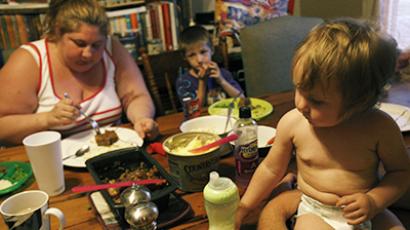Poor US kids poisoned by lead legacy, crippled by funding cuts

Over half-a-million American children could have lead poisoning, which could affect their development. Most of them come from poor families, but detecting the illness maybe complicated due to financing cuts.
The recent lowering of the maximum threshold of lead per deciliter of blood has made the number of American kids with suspected blood poisoning practically double.
A year ago, when the threshold was 10 micrograms, the number of kids under six years old potentially suffering from lead poisoning was estimated from 77,000 to 255,000.
Today, with a maximum 5 micrograms threshold, the number of kids potentially poisoned with lead is estimated at twice that, up to 535,000 children, meaning about one in 38 children under six. This age has been specifically chosen for testing because it is when kids are considered to be at the highest risk of neurological problems if lead poisoned.
The new data has been obtained by the Centers for Disease Control and Prevention (CDC) which took blood samples from 1,653 kids, around 50 of whom got unfavorable test results.
The CDC estimates the total number of American households contaminated with lead at 4 million.
The presence of excessive quantities of lead in the human body damages the brain and therefore reduces intelligence. It also impairs hearing, kidneys and the nervous system and can eventually even cause death. In the most serious cases, heavy metal detoxification is prescribed.
Lower levels of lead in human bodies can reduce intelligence, impair hearing and behavior and cause other problems.
Airborne dust containing tiny lead particles is believed to be the main source of high lead levels in industrial zones. Though lead has been consistently eliminated from technological processes such as paint production (banned in 1978), fuels (became unleaded in the late 1980s), water pipes and from food canning industry, vast quantities of the metal have already permeated soil, and exist in walls once painted with lead paint, etc.
“Often, children who get lead poisoning live in old homes that are dilapidated or under renovation. They pick up paint chips or dust and put it in their mouth. Children have also picked up lead poisoning from soil contaminated by old leaded gasoline, from dust tracked in from industrial worksites, from tainted drinking water,” and other sources, AP reported on the issue.
Wind and renovation works in old buildings and earthwork send miniscule lead particles into the air, and on into human lungs.
The latest CDC study once again confirmed that those families,
mostly African-American, living in poverty in contaminated
industrial neighborhoods risk their children’s’ health the
most.
“Persistent differences between the mean [blood lead levels] of different racial/ethnic and income groups can be traced to differences in housing quality, environmental conditions, nutrition, and other factors,” the statement CDC maintains.
But despite all the odds, the number of lead poisoning cases is slowly, but steadily going down, CDC experts shared. An 8.6 per cent decrease in childhood lead poisoning has been registered in the surveys conducted from 2007 to 2010 if compared with those in 1999-2002.
The new CDC survey admits that representative sampling has been
insufficient and most likely there are many unexamined children
suffering health problems because of lead poisoning. And a source
of contamination can usually be found in connection with diseased
persons.
Because of that, the biggest risk now threatening the American
healthcare system is growing underfinancing caused by budget cuts
in the US.
In 2012 the US Congress slashed the CDC lead program’s budget by almost 95 per cent, from about $29 million to a mere $2 million, which cut short CDC grants to local health departments.
With a dramatic drop in financing, national health departments have had to cut down their lead poisoning prevention programs and fire personnel.
If medical specialists stop testing and taking samples, the
problem of industrial contamination will not vanish, but there will
definitely be less noise in the media.














